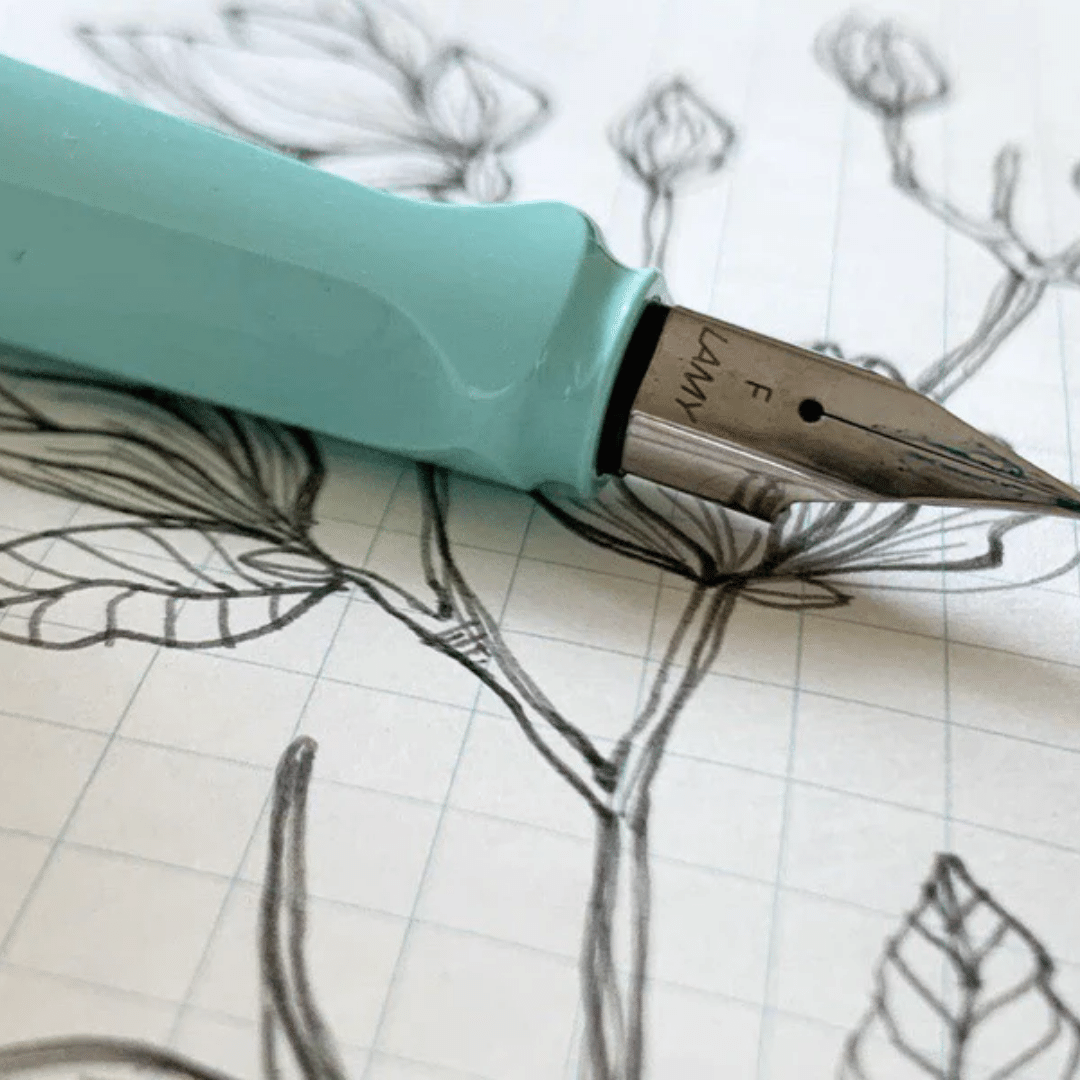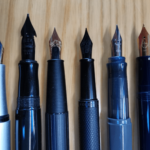
My Opinion Drawing with a Fountain Pen
So, traditionally, you don’t make drawing with a fountain pen, mainly because suitable ink has always been a problem. Dye ink used for fountain pens is rarely waterproof or lightfast. However, the fountain pen has probably been used for sketchbooks for as long as it has existed. Today, the inks are getting better and better, and reasonably durable fountain pen inks are also available.
In illustration, commercial graphics and the hobby sector, light fastness no longer plays such a big role because everything is digitized anyway. This is why fountain pens are being used more and more, especially as an uncomplicated device for sketches and illustrations.
However, I think anyone looking for a fountain pen as a 1:1 replacement for any other drawing device will probably be disappointed. Anyone who is willing to get involved with fountain pens or pen-like devices and get to know their strengths and weaknesses without bias can have interesting experiences. At least that’s how it was for me.
So-called document-safe inks are recommended as ink for drawing, usually these are nano inks. A search in the ink section of the forum provides enough suggestions. A cheap and very suitable alternative for me is Fount India from Pelikan.
It is almost waterproof, supposedly lightfast and suitable for fountain pens, although the fountain pen has to be cleaned regularly. Iron gall inks are not particularly suitable because they are very acidic, which also causes durability problems.
Almost any paper that you would otherwise use for pen drawings is suitable as paper, i.e. Bristol board or other smooth drawing paper. Age-resistant stationery can also be used. Soft or textured papers, such as those used for watercolors or dry drawing techniques, can be problematic, you have to try them out. Tip: Fountain pens with a generous ink flow work better on such papers than dry ones.
Normal fillers:
Standard fountain pens with round iridium writing grains are suitable for line drawings without much variation, similar to felt markers. They are available from thin to thick, from dry to juicy, so everyone has to find the right one for their own drawing style.
In any case, you should look for a good-natured pen that can be placed on the paper at different angles without scratching. Lamy (more dry) and Online Piccolo or Vision (more wet) have proven to be effective for me. In general, it can be worth looking at school and beginner fountain pens, as they tend to have good-natured nibs and are inexpensive. So it’s not a catastrophe if you ruin one with dried document ink.
Flexible feathers:
Everyone is looking for these as a possible replacement for drawing feathers for diving. Really good flexible nibs probably only exist in historical fountain pens. Only the fillers from Noodler are new. I can’t say much about it because I don’t have these fountain pens and I’m not a hero with the flex nibs for diving.
Apparently the stainless steel needed for fountain pens is simply no substitute for the materials used in dipping pens, and no one makes flexible gold nibs especially for us draftsmen anymore.
Ribbon nibs/calligraphy fountain pens:
Wide calligraphy nibs without iridium grain and possibly also stubs can be used in a similar way to a reed pen, but will probably not achieve their natural look. This makes it easier to use a fountain pen on the go.
There are such fillers from all sorts of manufacturers and all of the ones I tried were suitable. You can also choose based on the appearance and functionality of the entire filler.
You should make sure that the fillers can be dismantled for cleaning and can be placed from different angles without scratching. The parallel pens from Pilot are a special feature; due to their special design, the pen is supplied with ink across its entire width, not just through a central channel. If you like tension springs, you should give them a try.
Pan quill/Asian calligraphy quill.
These feathers are curved at the front similar to a European redis feather or pan feather. However, they are not round like the Redis feather but rather elongated. This means you can create many different lines with one pen and also easily fill larger areas. There are also historical European fountain pens with (more round) pan nibs.
These were used for simple, easy-to-read prints and were probably also used as an uncomplicated device for children and inexperienced people. Unfortunately, I don’t have any experience with these pens, but they are becoming more and more popular among draftsmen and the prices are falling accordingly. I’ll try them again.
Glass nib filler:
Only available historically or as a self-built one. I don’t have one, but I sometimes like to draw with a classic glass pen for a change. If I come across a glass nib fountain pen, I will grab it.
Normal glass feathers are available relatively cheaply at every craft market, you can just try them out. However, they are hard and offer little line variation.
They are good for drawings that are then very washed out or for drawing straight into the wet. You don’t have to worry about anything sticking to them, after they’ve dried you can scrape everything off.
Another advantage of glass nibs is that they also work on watercolor paper and almost any paper because of their hardness and the fairly wet ink flow.
Brush Pen/Brush Filler
These also come from Asia. They are devices that are operated like a fountain pen with cartridges, converters or, rarely, a tank, but have a small brush at the front instead of a spring. They were originally intended for Asian calligraphy, but they work well for drawing.
They are available with synthetic hair or real red sable hair. The latter are expensive and should only be used with the original ink made for it, I haven’t tried them yet.
With a little practice, the plastic brushes can be used like flexible springs to create waxing and waning lines. But you can just as easily use them loosely and picturesquely. I have a lot of fun with it. However, the ink flow is sometimes not sufficient for very rough or soft papers.
Water Brush
This is a small brush with a plastic water reservoir, is filled like an eyedropper and usually has to be pressed lightly so that liquid flows. They usually only cost a few euros.
They are actually intended as on-the-go watercolor brushes. They are also good for blurring drawings. You can also fill them with ink or (at your own risk) diluted watercolor paint if you want to try out a cheap brush pen. However, the ink flow is never as great as with a real brush fountain pen.
